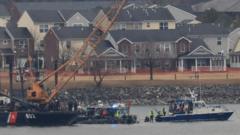In a devastating incident that has shocked the nation, authorities are in the midst of recovery operations following a catastrophic collision between an American Airlines passenger plane and an Army Black Hawk helicopter. The crash, which occurred on Wednesday, has claimed the lives of 67 individuals, including 64 passengers aboard the American Airlines flight and three soldiers in the helicopter.
The scene of the tragedy is the Potomac River, where extensive efforts are being made to retrieve both bodies and debris. As of Friday, officials have identified 28 victims and recovered 41 bodies, with hopes of locating the remaining individuals as soon as the aircraft is hoisted from the riverbed. The operation, which will be led by the U.S. Navy and commence on Saturday, aims to map the debris field to better understand the circumstances surrounding the collision.
The National Transportation Safety Board (NTSB) has recovered and is analyzing the black boxes from both aircraft. Todd Inman, an NTSB member, confirmed that the data extraction process is proceeding, with insights expected "very soon." However, the investigation into the cause of the crash remains ongoing, focusing on multiple factors including air traffic controller procedures.
With airspace in the area now under stricter regulations imposed by the Federal Aviation Administration (FAA), investigators are scrutinizing the actions of air traffic controllers, particularly in the critical hours leading up to the crash. Notably, President Donald Trump has voiced concerns regarding the incident's safety implications, connecting it to potential staff shortages and diversity hiring practices at the FAA.
The community is mourning the loss, and the recovery efforts are a race against time. More than 500 responders have been working tirelessly at the crash site, aiming not only to recover victims but also to uncover the root causes of this tragic accident to prevent similar occurrences in the future.
The scene of the tragedy is the Potomac River, where extensive efforts are being made to retrieve both bodies and debris. As of Friday, officials have identified 28 victims and recovered 41 bodies, with hopes of locating the remaining individuals as soon as the aircraft is hoisted from the riverbed. The operation, which will be led by the U.S. Navy and commence on Saturday, aims to map the debris field to better understand the circumstances surrounding the collision.
The National Transportation Safety Board (NTSB) has recovered and is analyzing the black boxes from both aircraft. Todd Inman, an NTSB member, confirmed that the data extraction process is proceeding, with insights expected "very soon." However, the investigation into the cause of the crash remains ongoing, focusing on multiple factors including air traffic controller procedures.
With airspace in the area now under stricter regulations imposed by the Federal Aviation Administration (FAA), investigators are scrutinizing the actions of air traffic controllers, particularly in the critical hours leading up to the crash. Notably, President Donald Trump has voiced concerns regarding the incident's safety implications, connecting it to potential staff shortages and diversity hiring practices at the FAA.
The community is mourning the loss, and the recovery efforts are a race against time. More than 500 responders have been working tirelessly at the crash site, aiming not only to recover victims but also to uncover the root causes of this tragic accident to prevent similar occurrences in the future.

















